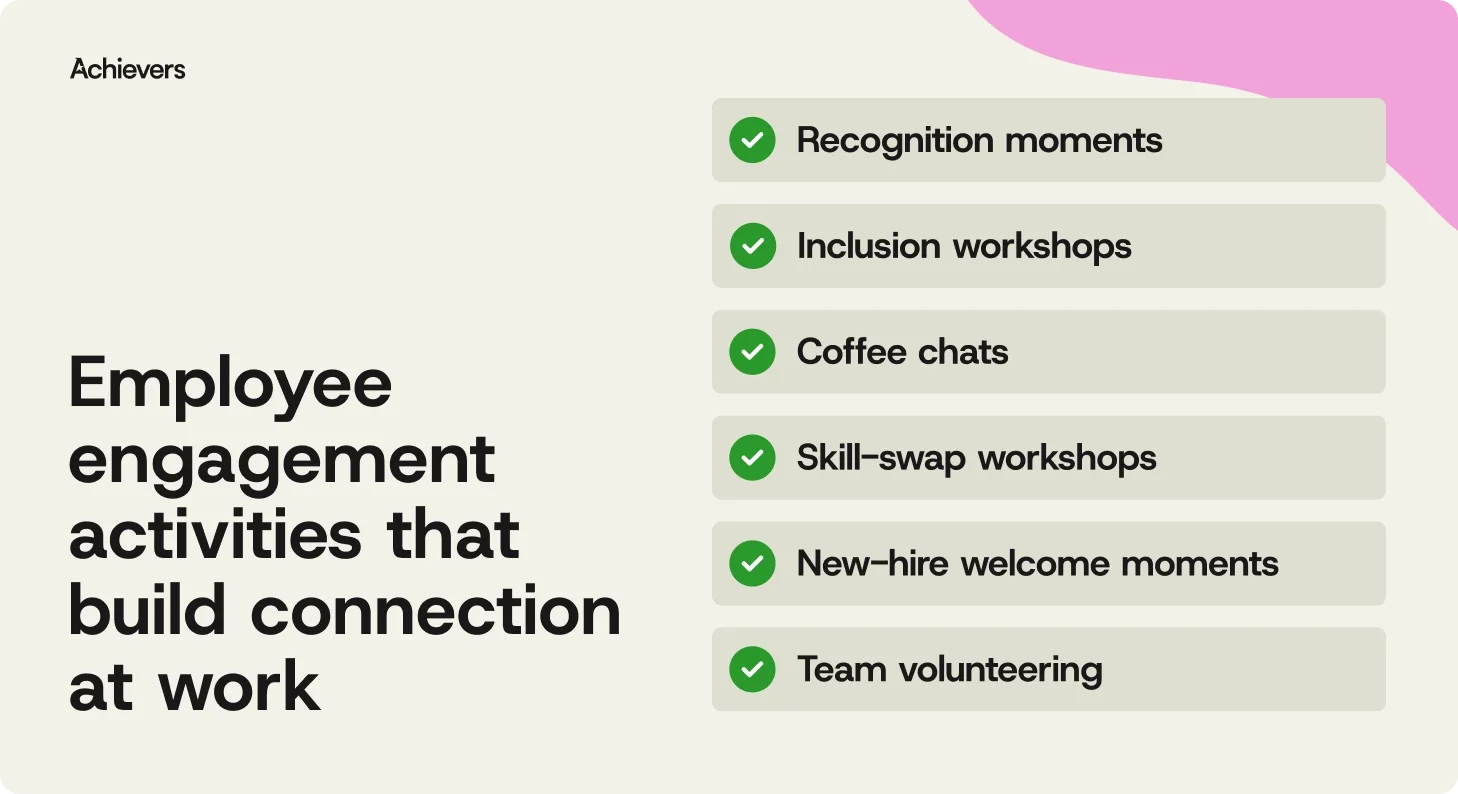Table of contents
Create a culture that means business™
Schedule a demo with an Achievers solution expert today.
Employee engagement isn’t something you can fake. People can tell when it’s just lip service — and they check out fast. According to Achievers’ 2024 Engagement and Retention Report, 41% of employees planned to job hunt last year, and another 24% weren’t sure if they’d stay. That’s two-thirds of the workforce on the fence. But when engagement is part of everyday work life? That’s when things start to click.
Too often, though, engagement activities are scattered, inconsistent, or treated like a once-a-year team lunch. If you want people to feel connected, motivated, and appreciated, you’ve got to be more intentional.
The good news? It doesn’t take a large budget or a flashy program. Just a few thoughtful activities that show your people you’re paying attention — and that what they do every day matters.
Employee engagement activities that build real connection
Real engagement starts with connection — to purpose, to teammates, and to the company culture you’re building together. But connection doesn’t just happen. It takes small, consistent moments that make people feel like they belong and that their work matters.
The ideas below help turn everyday interactions into something more meaningful:

Culture-building activities
Culture isn’t what you write on a wall. It’s how people experience your workplace every day. When engagement efforts reflect your values in action, your culture starts to feel real — and worth being part of. Examples of activities include:
- Values-based recognition moments: If values live only on a poster, they’re not doing much. Recognize the behaviors that reflect what your culture looks like in motion — whether it’s teamwork, curiosity, or knowing when to step up (or step aside). A little consistency makes “what good looks like” clear — and contagious.
- Team storytelling sessions: People may forget an all-hands update, but they’ll remember a good story. Create space for employees to share real experiences around growth or purpose. It’s an easy, low-tech way to build empathy — and remind folks they’re not in it alone.
- Inclusion workshops or coaching: Inclusion doesn’t magically happen because you updated the handbook. Make it real with sessions that explore what inclusion looks like in practice — in conversations, in decisions, in the day-to-day moments that matter. Tie it to key moments or make it part of your regular rhythm. Better yet, both.
Connection and team bonding activities
Trust grows through shared experiences, not just team goals. When people have the tools to connect outside of their roles, it’s easier to work together when it counts. Examples of activities include:
- Randomized coffee chats: No agenda. No prep. Just two people connecting outside their usual circles. These quick pairings — virtual or in-person — create space for conversations that don’t happen in meetings and give employees a chance to get to know their peers on a personal level.
- Themed team trivia or challenges: Nothing brings a team together like a little friendly competition. Host casual trivia games or themed challenges that blend fun with collaboration — think company history, pop culture, or international holidays. Keep it low-pressure and high-energy, and look for ways to tie in core values along the way.
- Interactive polls and personality games: Sometimes, the easiest way to spark connection is with a simple question. Try quick polls or low-stakes personality quizzes. Add in a few great icebreaker questions during meetings or in chats to help people open up, laugh a little, and get to know each other beyond job titles.
Growth and development activities
Most people want to grow, but not everyone knows how to ask for it. Creating learning opportunities that feel practical and supported helps employees show up with more confidence and curiosity. Examples of activities include:
- Skill-swap workshops: People have more to teach than we give them credit for. Let them share shortcuts, hacks, or hard-earned insights. It builds confidence, curiosity, and cross-functional respect — all without adding headcount.
- Job shadowing days: Let employees see what a day in someone else’s role really looks like. Shadowing helps people explore new career paths, build empathy, and understand how different teams work together to move the business forward.
- Lunch-and-learn speaker series: You don’t need a corporate offsite to spark fresh thinking. Bring in a guest (or a teammate with a story) to share something useful. Keep it optional, relevant, and refreshingly low on slide decks.
- Project-based learning opportunities: Growth doesn’t need a name tag or a title change. Let employees stretch beyond their usual work — help solve a business challenge, join a new team, or test a tool. It’s real development, in real time.
Celebrations and milestone activities
Recognition doesn’t need to be elaborate, it just needs to feel genuine. When you acknowledge the moments that matter, people are more likely to feel seen, valued, and invested in the work. Examples of activities include:
- Work anniversaries done right: People notice when you notice. Skip the template message and share a quick highlight or story instead. And if you’re managing a global team, don’t leave recognition to time zones and good intentions — a global recognition platform helps make it consistent.
- New hire welcome moments: Nothing says “you belong here” like a warm welcome on day one. A quick team message or “get to know me” post can help ease the awkwardness — and spare new hires from a dozen “So, what do you do?” intros.
- Birthday spotlights: A well-timed birthday shout-out can brighten someone’s day — and avoid the dreaded “I forgot your birthday” guilt spiral. A message in Slack, Teams, or your intranet keeps it simple and celebratory, without the pressure of cake or awkward singing. Just make sure people can opt in (or out). Not everyone wants their birthday posted on the company feed.
- Life moment shout-outs: People don’t hit milestones only at work — and recognizing what’s happening outside the office shows you value the whole person, not just the job title. Whether it’s buying a first home, finishing a degree, or running that marathon they swore they’d never sign up for, a simple shout-out can go a long way.
Lighthearted activities
Sometimes the most impactful engagement moments are the ones that feel easy. A shared laugh, a quick break, or time outside together can do more for morale than another meeting invite. Examples of activities include:
- Wellness walks or walking meetings: Sometimes the best way to get a fresh perspective is to get moving. Encourage quick walk-and-talks — whether it’s in-person or a phone call on the go. The goal isn’t hitting 10,000 steps. It’s stepping away from screens, having a real conversation, and returning with a clearer head (and maybe fewer Slack notifications).
- Team volunteering days: Doing good together is good for connection, too. Organize a volunteer day where your team can support a local cause — whether it’s packing lunches, planting trees, or sorting donations. It’s a meaningful way to spend time together that doesn’t involve deadlines, status updates, or spreadsheets.
- Outdoor team lunches or picnics: Not every team outing needs a packed agenda. Sometimes, fresh air and sandwiches do the trick. Find a spot outside — the office patio counts — and give people a chance to connect without a calendar invite hovering overhead.
- Stretch or mindfulness breaks: Back-to-back meetings aren’t a badge of honor. Include moments of wellness in the day-to-day — a guided stretch, a few minutes of deep breathing, or even a “cameras-off” reset. It doesn’t take much to help people feel more grounded — just a few minutes of space to slow down and reset before diving back in.
Make engagement stick with meaningful recognition
You can plan the most creative, well-intentioned engagement activities out there — but if no one feels genuinely seen for the effort they put in, the impact won’t last.
That’s where recognition comes in. It’s the thread that ties all your engagement efforts together and turns good moments into lasting momentum. When employees are consistently recognized — not just for big wins, but for the everyday things that make teams work — they stay more connected, more motivated, and more invested.
Done with intention, recognition can help you:
- Reinforce the behaviors that drive culture (not just the ones that show up in a values poster)
- Make engagement feel personal — not like a program
- Keep your best people from quietly disengaging or walking out the door
- Tie every activity to a bigger impact — from culture alignment to business performance
- Show employees that what they do every day really matters
When appreciation is part of the everyday experience — not just an add-on — engagement doesn’t just stick. It scales. It strengthens your culture. And it delivers results. According to Gallup, highly engaged teams see 17% higher productivity and 21% greater profitability — clear proof that when you invest in your people, the business wins too.
At Achievers, we make it easy to build the kind of culture where recognition happens in the moments that matter.
Turn employee engagement activities into everyday impact
From coffee chats to recognition moments, the most effective employee engagement activities share one thing in common: they’re intentional. They meet people where they are, support everyday connection, and reinforce the kind of culture you’re trying to build — not just once in a while, but all the time.
But even the best activities won’t stick without the right support behind them.
Achievers helps turn these efforts into habits with a platform designed to make appreciation easy, feedback actionable, and engagement part of the everyday experience.
With real-time recognition, a global rewards marketplace, always-on feedback, and the industry’s highest recognition frequency, Achievers gives your people what they need to stay connected, motivated, and inspired — every day, at the moments that matter most.



